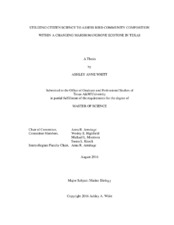| dc.description.abstract | Climate change is likely to drive large geographic species shifts such as woody encroachment into grassland ecosystems. Along the Gulf of Mexico, this shift manifests as a change from grass-dominated salt marshes to woody black mangrove stands. Such changes are likely to affect the multidimensional habitat space that birds rely on, but how bird communities will respond to this shift is poorly understood. This study utilized citizen scientist observations to provide an initial assessment of how bird community compositions differ within a mangrove-marsh ecotone in Texas. Citizen science, the public's involvement in data collection, can allow ecologists to feasibly investigate larger spatial and temporal patterns than otherwise possible. We overlaid observations of wading, shorebird and passerine assemblages from Cornell's Lab of Ornithology's eBird database onto vegetation distribution maps in ArcGIS. We designated study sites by using spatial analysis tools and assessed bird use of mangrove and marsh sites in the central (San Patricio and Nueces counties) and lower (Cameron county) regions of Texas.
Bird use significantly differed between mangroves and marshes, but general patterns of use varied amongst study regions. Marshes in the central region supported significantly more bird species and higher abundances than mangrove sites. Lower region marshes had significantly higher bird species diversity per sampling event. Bird assemblages were dissimilar, with some species overlap between central region marshes and mangrove communities. Waders were common in all vegetation types and regions, but wader abundances were somewhat higher in marshes than in mangroves in the central region. In general, larger abundances of shorebirds were observed at either region's marsh sites than mangroves. Passerines species generally targeted by birdwatchers, such as migratory warblers, were only observed at marsh sites in the central region. Overall, these results suggest that a shift in the marsh-mangrove ecotone along coastal Texas affects bird community compositions. This initial assessment will enhance the ability of scientists and policymakers to shape coastal management strategies that protect vital habitat for bird communities under climate change scenarios. | en |


